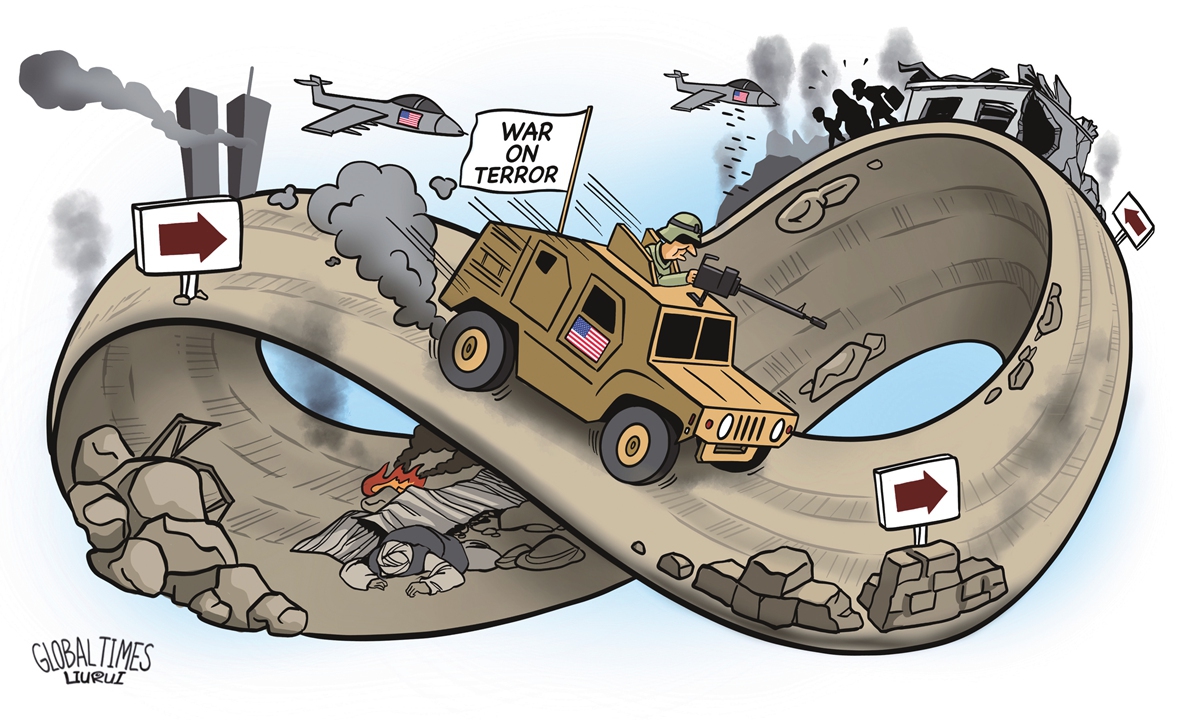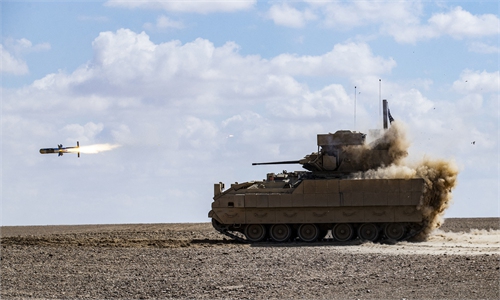
Illustration: Liu Rui/GT
According to the recently released "2023 Index of US Military Strength," published by the Heritage Foundation, "As currently postured, the US military is at growing risk of not being able to meet the demands of defending America's vital national interests. It is rated as weak relative to the force needed to defend national interests on a global stage against actual challenges in the world as it is rather than as we wish it were."During the Cold War, the US national security posture was designed to wage two and one-half wars - two major regional conflicts (for instance, fighting a Soviet invasion of Europe), while fighting a "holding action" in a third theater (such as the Middle East) until one of the major conflicts was won, and the military resources used were then reassigned.
When the Soviet Union collapsed, the US sought to take advantage of the so-called peace dividend by downsizing to a more modest "one and a half" war capability. Then 9/11 came, and the US became singularly focused on the "Global War on Terror." Literally every aspect of the US military industrial complex was refocused on defeating the nebulous "terrorist" foe in Afghanistan, Iraq, Yemen, Somalia, Syria… and more.
The Gulf War of 1991 showed the US at its absolute best, able to project thousands of aircraft, dozens of naval vessels, and some 700,000 troops along with tens of thousands of tanks, armored fighting vehicles, self-propelled artillery, and other support vehicles into a foreign land thousands of miles from their home bases, along with sufficient ammunition, fuel, and other logistics support necessary to sustain this force for the duration of the conflict.
A dozen years later, in 2003, the US invaded Iraq with a much-diminished force, less than one third of what had been assembled in 1991; US military strength was already significantly degraded. Gone was the massive multi-corps force that had existed in West Germany during the Cold War. Gone, too, were most of the active-duty divisions that had served in the Gulf War.
To supplement the diminished active-duty force structure of 2003, the US had to mobilize units drawn from the reserves and National Guard. While these forces were sufficient for the task of occupying Iraq and fighting a counterinsurgency, they lacked any capability to wage the kind of comprehensive large-scale combined arms warfare that was the US military's bread and butter during the Cold War era.
Moreover, after two decades of non-stop deployments in support of low-intensity conflicts, the active-duty forces of the US Army likewise lost their ability to engage a peer or near-peer force, such as China, Russia, North Korea, or even Iran. Large-scale ground combat was a skillset the US military was no longer organized, trained, or equipped to fight.
This is the reality that is captured by the Heritage Foundation report. While the US Army, the report notes, "has sustained its commitment to modernizing its forces for great-power competition, its modernization programs are still in their development phase, and it will be a few years before they are ready for acquisition and fielding. In other words," the report concluded, "the Army is aging faster than it is modernizing."
The Army's strength was graded as "marginal."
In case any aging Cold War warriors think the US Air Force would fly to the rescue, think again. "Aging aircraft and poor pilot training and retention," the report said, "continue to degrade the ability of the Air Force to generate quality combat air power needed to meet wartime requirements. It would be difficult for the Air Force to respond rapidly to a crisis and dominate airspace without increased pilot training and numbers of fifth-generation weapon systems."
The Air Force got a strength rating of "weak."
Even the US Navy also got a cold dose of reality. "Competitors are quickly narrowing the technology gap in their favor as the Navy's ships decrease in numbers and abilities," the Heritage report noted.
Like the Air Force, the Navy was graded as "weak."
Only the US Marine Corps got a strength rating of "strong," but this was only achieved by focusing on the ability to fight a single war at a time. Gone are the days that the US military could dream of fighting two and a half, or even one and a half, wars.
As things stand now, the Heritage Foundation report concludes, "the current US military force is at significant risk of not being able to meet the demands of a single major regional conflict."
This is a reality that US policymakers should let sink in before they stir up trouble around the world. Unlike past years, the cavalry may not, in fact, be able to ride to the rescue.
The author is a former US Marine Corps intelligence officer. opinion@globaltimes.com.cn



